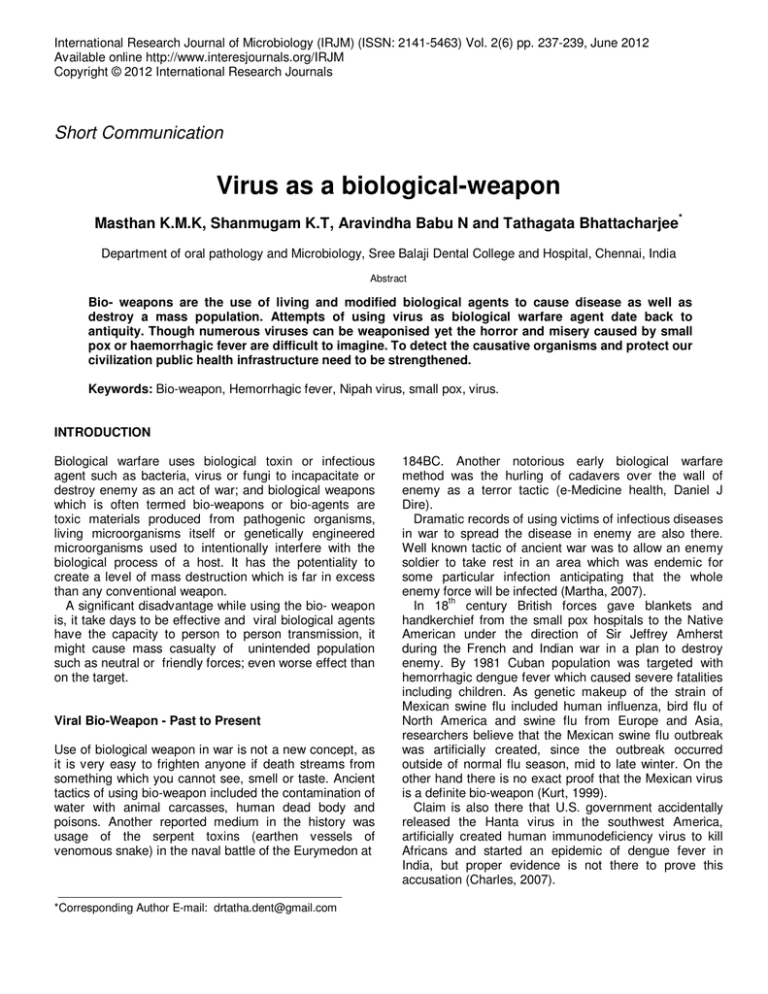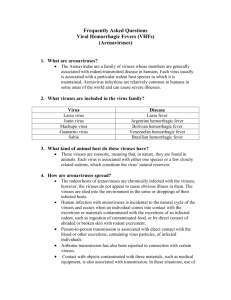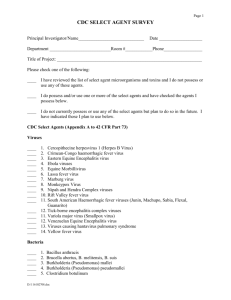Document 14104879
advertisement

International Research Journal of Microbiology (IRJM) (ISSN: 2141-5463) Vol. 2(6) pp. 237-239, June 2012 Available online http://www.interesjournals.org/IRJM Copyright © 2012 International Research Journals Short Communication Virus as a biological-weapon Masthan K.M.K, Shanmugam K.T, Aravindha Babu N and Tathagata Bhattacharjee* Department of oral pathology and Microbiology, Sree Balaji Dental College and Hospital, Chennai, India Abstract Bio- weapons are the use of living and modified biological agents to cause disease as well as destroy a mass population. Attempts of using virus as biological warfare agent date back to antiquity. Though numerous viruses can be weaponised yet the horror and misery caused by small pox or haemorrhagic fever are difficult to imagine. To detect the causative organisms and protect our civilization public health infrastructure need to be strengthened. Keywords: Bio-weapon, Hemorrhagic fever, Nipah virus, small pox, virus. INTRODUCTION Biological warfare uses biological toxin or infectious agent such as bacteria, virus or fungi to incapacitate or destroy enemy as an act of war; and biological weapons which is often termed bio-weapons or bio-agents are toxic materials produced from pathogenic organisms, living microorganisms itself or genetically engineered microorganisms used to intentionally interfere with the biological process of a host. It has the potentiality to create a level of mass destruction which is far in excess than any conventional weapon. A significant disadvantage while using the bio- weapon is, it take days to be effective and viral biological agents have the capacity to person to person transmission, it might cause mass casualty of unintended population such as neutral or friendly forces; even worse effect than on the target. Viral Bio-Weapon - Past to Present Use of biological weapon in war is not a new concept, as it is very easy to frighten anyone if death streams from something which you cannot see, smell or taste. Ancient tactics of using bio-weapon included the contamination of water with animal carcasses, human dead body and poisons. Another reported medium in the history was usage of the serpent toxins (earthen vessels of venomous snake) in the naval battle of the Eurymedon at *Corresponding Author E-mail: drtatha.dent@gmail.com 184BC. Another notorious early biological warfare method was the hurling of cadavers over the wall of enemy as a terror tactic (e-Medicine health, Daniel J Dire). Dramatic records of using victims of infectious diseases in war to spread the disease in enemy are also there. Well known tactic of ancient war was to allow an enemy soldier to take rest in an area which was endemic for some particular infection anticipating that the whole enemy force will be infected (Martha, 2007). In 18th century British forces gave blankets and handkerchief from the small pox hospitals to the Native American under the direction of Sir Jeffrey Amherst during the French and Indian war in a plan to destroy enemy. By 1981 Cuban population was targeted with hemorrhagic dengue fever which caused severe fatalities including children. As genetic makeup of the strain of Mexican swine flu included human influenza, bird flu of North America and swine flu from Europe and Asia, researchers believe that the Mexican swine flu outbreak was artificially created, since the outbreak occurred outside of normal flu season, mid to late winter. On the other hand there is no exact proof that the Mexican virus is a definite bio-weapon (Kurt, 1999). Claim is also there that U.S. government accidentally released the Hanta virus in the southwest America, artificially created human immunodeficiency virus to kill Africans and started an epidemic of dengue fever in India, but proper evidence is not there to prove this accusation (Charles, 2007). 238 Int. Res. J. Microbiol. Use of Virus as Bio-Weapon followed by macules over the face and extremities appears. Macule evolves to papules. After 5-8days of persistence the pustule crusts (e-Medicine health, Daniel J Dire). Clinical findings are mainstay of diagnosis but it can be confirmed by PCR, cell culture and electron microscopy. Till date no known antiviral drug is effective. Only vaccine contributes to immunity in 95%of population. The Centre for Disease Control and Prevention (CDC) listed critical biological agents for public health preparedness, based on ease of transmission, severity of morbidity and mortality as well as likelihood of use. They categorise the agents as A, B or C. Category-A bio agents can be easily disseminated or transmitted person to person and have the potentiality for major public health impact as they result in high mortality rates. The viruses that come under this category are Variola major (Small pox virus), Filo viruses (as example Ebola, Marburg) and Arena viruses (as example Lassa, Machupo, Junín and related virus). As category -A agents have the potentiality for airborne transmission these are considered especially dangerous (Centres for disease control and prevention, Bioterrorism Agents/Diseases, www.cdc.gov). Category -B bio agents (Second Highest Priority Agents) can be moderately easy to disseminate and causes moderate morbidity and low mortality. Alpha viruses which includes Venezuelan encephalomyelitis and eastern and western equine encephalomyelitis comes under this category (Centres for disease control and prevention, Bioterrorism Agents/Diseases, www.cdc.gov). Category C bio agents (Third Highest Priority Agents) include emerging pathogen which could be bioengineered for mass destruction as these are easy to produce and disseminate and having potentiality for high morbidity and mortality. The viruses that come under this category are Nipah virus, Hantaviruses, Tick borne hemorrhagic fever viruses, tick borne encephalitis viruses and yellow fever virus (Centres for disease control and prevention, Bioterrorism Agents/Diseases,www.cdc.gov). Hemorrhagic fever viruses are lipid enveloped small RNA virus weaponised by both former Soviet Union (Marburg, Ebola, Lassa and Junín virus) and the United states (Yellow fever and Rift valley fever). This virus belong to four families within which Filo viridae and Arena viridae are associated with bio terrorism. These viruses are most deadly and least understood at present world (Borio et al., 2002). Humans are only incidental host. Transmission is by contact with infected rodent excreta. Incubation time is 221 days. High fever, headache, arthralgias, myalgias and abdominal pain are preliminary symptoms. Conjunctivitis, pharyngitis, patechiae and purpura of conjunctivae and mucosa followed by gastrointestinal bleeding and urinary tract bleeding occur. Soon death follows due to multiorgan failure and shock. Common hospital laboratories are not capable to confirm the diagnosis. Leucopoenia, anaemia due to haemorrhage, thrombocytopenia, elevated liver enzymes and disseminated intravascular coagulations are the common findings. Supportive treatments are the mainstay. Only few vaccines developed till date. Small Pox Nipah Virus It is very difficult to forget the horror and misery the disease created in the world in 20th century. The last naturally occurring case of smallpox was diagnosed from Somalia in 1977 and last case in human was found in1978 due to lab accident in UK .The world was declared free from the disease by WHO in 1980.At present all declared live smallpox virus are combined and stored only in two WHO approved centre. One in Centres for Disease Control (CDC), Atlanta, USA and another in Vector, Novosobirsk, Russia (McFadden, 2010). Small pox is a single-stranded DNA virus. They come under Pox Viridae family like monkey pox or vaccinia. No known non-human reservoir exists. Incubation period is 7-17days and prodromal symptoms are characterised by headache and backache. After fever oral exanthema Newly emerging deadly paramyxo virus has the potentiality to cause bioterrorism. It is considered very dangerous due to high mortality and inability to control the disease. The high virulent virus easily infects pigs and transmits to humans especially those who comes close contact to them. Dogs, cats, horses are also natural reservoirs. Clinical symptoms include brain dysfunction with hypertension and tachycardia, followed by rapid deterioration which leads to irreversible hypotension and death. Laboratory investigation shows thrombocytopenia, leucopoenia, elevated levels of alanin aminotransferase and aspertate aminotransferase (Lam, 2003). Due to broad spectrum activity against both RNA and DNA viruses, Ribavirin is considered as drug of choice (Lam, 2003). Hemorrhagic Fever Masthan et al. 239 Viral Bio-Weapon, Its Hazard and Prevention Though it is very difficult to provide proper protection to people those who are involve in production, transportation, loading and delivery system, yet various terrorist groups often choose biological weapon for their attack because the materials, equipments and production are very less expensive (Arora et al., 2002; Rebecca, 2001). Difficulty is also there to deliver bio-weapon effectively as most of the biological material are destroyed by UV light exposure and drying. Wind pattern dispersed bioagents in unexpected ways and lack of control during harvesting agents or poor storage leads to loss of its viability (Arora et al., 2002). India is a country with high population density, so the biological attack in India will be devastating and as Indian cities are gateway to whole world, infections can spread to various populations before any symptom manifests (US embassy cables,www.guardian.co.uk, 2010). To minimize or prevent casualty, biological defence requires a sensitive environmental monitoring system for detection of infectious biological material present in that particular area. It should be very sensitive as well as reliable with capability of determining whether a previous contaminated area is safe or not. At present time, there are no such means of detecting biological agents in the environment (Martha, 2007). A biological integrated detection system is proposed to have setting within few years which can test environmental air by concentrating aerosol particle size (Martha, 2007). Tactile Biological Standoff detection system is also planned for future to provide early warning and activating NBC warning and reporting system. Using ultraviolet laser and laser induced fluorescence it will be able to detect aerosol cloud up to 5 km. It will be available for fixed-site or insert into various transport platform (Martha, 2007). CONCLUSION In recent time, to name few, Japan, Germany, USA, Russia, Iraq, Bulgaria, UK and North Korea are involved in developing bio-weapon in spite of being aware of its inherent danger and complexities of its production (Charles, 2007). If the development process of weapon itself causes more injury and death to one’s own people than to opposition, that alone would cause sensible people to give it a second thought (Charles, 2007). Today our society have enormous resources. They can move gene, virus to virus, know to delete and insert things to produce right mutation (Charles, 2007). But to prove it people are killing each other in a new way every time. The threat of bio-attack is now a reality. Though there is no guaranteed way of protection against bio-attack yet improved monitoring of environment, adequate prophylactic drug and vaccine, highly sensitive and specific diagnostic aids and overall intelligent planning can defend against possible nightmare of virus used as biological-weapon. REFERENCES Arizona Department of Health Services (2004). Division of Public Health Services|Office of Public Health Emergency Preparedness and Response 4(24):4-29 DR Arora, V Gautam, B Arora (2002). Biological warfare: Bioterrorism 20(1):6-11 Indian J. Med. Microbiol. Borio L, Thomas Ingles, CJ Peters, Alan L Schmaljohn, James M Hughes, Peter B Jahrling, Thomas Ksiazek, Karl M Johnson, Andrea Meyerhoff, Tara O'Toole, Michael S Ascher, John Bartlett, Joel G Breman, Edward M Eitzen, Margaret Hamburg, Jerry Hauer, DA Henderson, Richard T Johnson, Gigi Kwik,Marci Layton, Scott Lillibridge, Gary J Nabel, Michael T Osterholm, Trish M Perl, Philip Russell, Kevin Tonat (2002). Hemorrhagic fever viruses as biological weapons: medical and public health management. JAMA, 287:2391405. PMID: 11988060[PubMed] Breman JG, Henderson DA (2002). Diagnosis and management of smallpox. N. Engl. J. Med. 346:1300-1308. PMID: 11923491[PubMed] Centres for disease control and prevention, Bioterrorism Agents/Diseases CDC 24/7.saving lives, protecting people,reducing health costs, www.cdc.gov Charles H (2007). Calisher|Let’s Get Something Straight/ Bioterrorism or Natural Disasters: What Shall We Worry about Next? Croat Med. J.48:574-578 Daniel J Dire, Biological Warfare. eMedicine health(www.emedicinehealth.com) Friedrich F (2003). The history of biological warfare| science and society EMBO reports. 4(Supp1): S47–S52 Karen Krisher, Judith L (2003). Sentinel Laboratory guidelines for suspected agents of bioterrorism/Unknown Viruses/American Society for Microbiology|10/10/03. 1-15 Kurt N (2009). Weaponizing Deadly Viruses: Historical Precedents| Tuesday, April 28, 2009.truth 11.com Lansing Dickinson E (1999 September). The Military Role in Countering Terrorist Use of Weapons of Mass Destruction September. Paper no 1. Bray M (2003). Defence against filo viruses used as biological weapons|Antiviral Research 57:53–60. Martha Lenhart K (2007). Medical Aspects of Biological Warfare pp.1-20 and pp. 437-450. McFadden G (2010). Killing a Killer: What Next for Smallpox? PLoS Pathog 6(1): e1000727. doi:10.1371/journal.ppat.1000727. Morrow MP, Yan J, Khan AS, Broderick KE, Sardesai NY (2012) What the Novel H1N1 Influenza Outbreak Can Teach us about Influenza as a Bioterrorism Weapon. J Bioterr Biodef S1:011. Rebecca K (2001). Biological Weapons: A National Security Problem that Requires a Public Health Response/ Office of Population Research Princeton University Working paper 4,1-38. Lam SK (2003).Nipah virus—a potential agent of bioterrorism?| Antiviral Research 57:113–119. U.S. Department of Health and Human Services, 03. Biological agents| September (2005).40-93 US embassy cables: US fears possible bio terror attack in India| www.guardian.co.uk, Thursday 16 December 2010 21.30 GMT Gautam V, Shekhar S, Arora D, Arora B (2008). Bioterrorism: Historical Prospective. The Internet Journal of Biological Anthropology. Volume 1 Number 2 doi:10.5580/25f1





